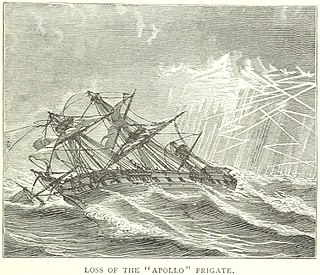Related Research Articles
Eleven ships of the Royal Navy have been named HMS Antelope, after the Antelope:
HMS Pickle was a topsail schooner of the Royal Navy. She was originally a civilian vessel named Sting, of six guns, that Lord Hugh Seymour purchased to use as a tender on the Jamaica station. Pickle was at the Battle of Trafalgar, and though she was too small to take part in the fighting, Pickle was the first ship to bring the news of Nelson's victory to Great Britain. She also participated in a notable single-ship action when she captured the French privateer Favorite in 1807. Pickle was wrecked in 1808, but without loss of life.

HMS Anson was a ship of the Royal Navy, launched at Plymouth on 4 September 1781. Originally a 64-gun third rate ship of the line, she fought at the Battle of the Saintes.

HMS Apollo, the fourth ship of the Royal Navy to be named for the Greek god Apollo, was a fifth-rate frigate of a nominal 36 guns. She was the name ship of the Apollo-class frigates. Apollo was launched in 1799, and wrecked with heavy loss of life in 1804.

HMS Tartar was a 32-gun fifth-rate Narcissus-class frigate of the Royal Navy, built at Frindsbury and launched in 1801. She captured privateers on the Jamaica station and fought in the Gunboat War and elsewhere in the Baltic before being lost to grounding off Estonia in 1811.

HMS Sappho was a Cruizer class brig-sloop built by Jabez Bailey at Ipswich and launched in 1806. She defeated the Danish brig Admiral Yawl in a single-ship action during the Gunboat War, and then had a notably successful two months of prize-taking in the first year of the War of 1812. She was wrecked in 1825 off the Canadian coast and then broken up in 1830.
There have been twelve ships of the Royal Navy that have been named HMS Flying Fish, after the Flying Fish.
Four vessels of Britain's Royal Navy have borne the name HMS Dominica, named for the island of Dominica.
Ten ships of the Royal Navy have borne the name HMS Renard, or HMS Reynard, after the French for fox, and the anthropomorphic figure of Reynard:
HMS Flying Fish was the American-built schooner Flying Fish, launched in 1801. She became the French privateer schooner Poisson Volant, which the British captured in 1803 in the West Indies and took into the Royal Navy. She captured a privateer and recaptured some small merchant vessels. She was renamed Firefly in 1807, but was lost with all hands when she foundered later that year.
At least six vessels of the Royal Navy have borne the name HMS Netley, named for the village of Netley.
HMS Barbara was an Adonis class schooner of the Royal Navy and launched in 1806. A French privateer captured her in 1807 and she became the French privateer Pératy. The Royal Navy recaptured her in 1808. She was paid off in June 1814 and sold in February 1815.
Numerous vessels have borne the name Active :
Three vessels of the British Royal Navy have borne the name Morne Fortunee for Morne Fortuné:
Several vessels of the British Royal Navy have been named HMS Redridge:
References
- ↑ "Royal Naval Ships built in Bermuda", (1961), Bermuda Historical Quarterly, vol 18 no2.
- ↑ "No. 15620". The London Gazette . 13 September 1803. p. 1228.
- ↑ "(untitled)". The Times (15802). London. 28 May 1835. col B, p. 3.
- ↑ Gilly, William O.S. (1850). Narratives of Shipwrecks of the Royal Navy: between 1793 and 1849, by William Octavius Shakespeare Gilly. London: John W. Parker, West Strand. Retrieved 27 February 2015.